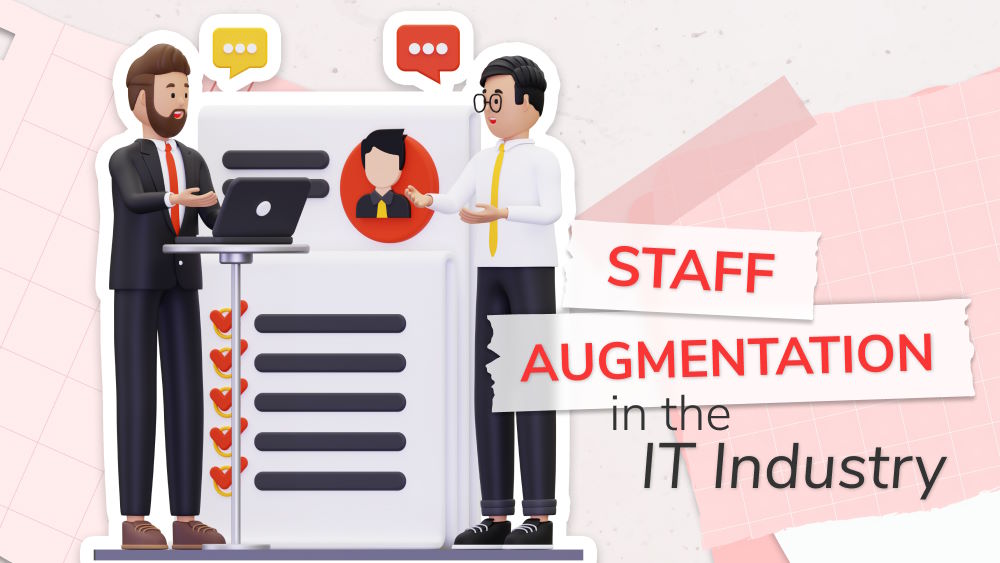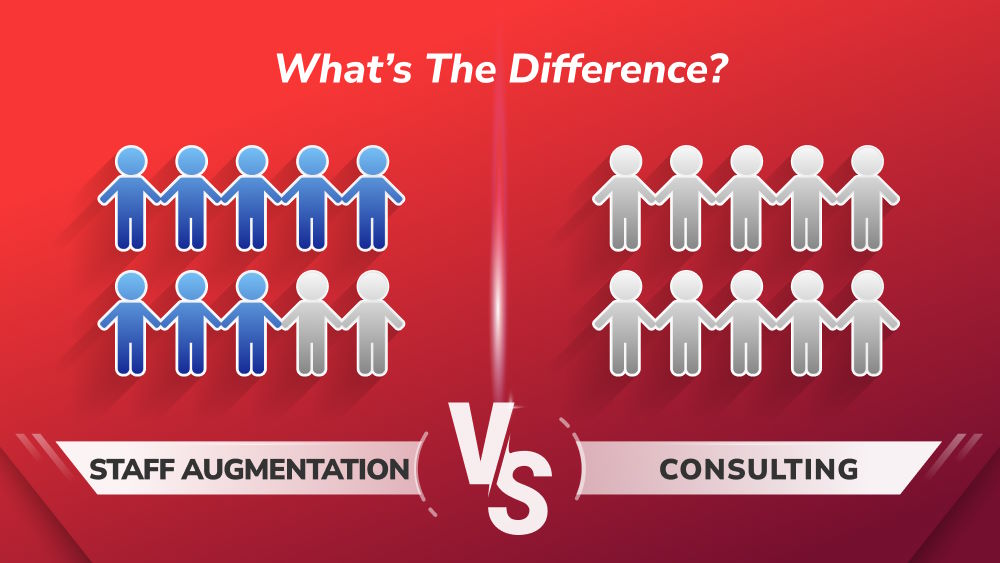How to Choose Between Staff Augmentation vs Outsourcing

Content Map
More chaptersIn the IT industry, each company has its own unique staffing requirements. Some companies require staff with specialist skills on a temporary, short-term basis. While other companies require an entire third-party team to complete an entire project. Whichever situation your company finds itself in, when the time comes to enlist help from the outside you have to ask yourself: staff augmentation vs outsourcing?
Understanding the differences between staff augmentation vs outsourcing, including their pros and cons, will help you get the most out of the staff you bring on board to complete your next project. So, without further ado, let’s first cover what staff augmentation and outsourcing are and what sets them both apart.
What is Staff Augmentation?
Staff augmentation is when you enlist the help of an outside third-party on a temporary basis to help your organization. These are specialists that you hire on a temporary, short-term basis in order to fulfill technical gaps that exist within your company.
You are responsible for on-boarding augmented staff into your business by informing them on your company culture, policies, procedures, and the expectations of their role. In essence, augmented staff get integrated with your existing company without actually becoming permanent full-time employees. You will also save money on paying yearly salaries and employment benefits such as holiday pay and sick leave.
In addition to this, you are responsible for equipping your augmented staff with the necessary tools, resources, and equipment that they need to work for you. However, some augmented staff service providers may be able to take care of this for you, depending on the nature of their working arrangement with you.
Pros of Staff Augmentation
Cost efficient
When comparing staff augmentation vs outsourcing, hiring augmented staff is an excellent way to save money. Instead of committing to hiring permanent full-time employees, you can simply request the augmented staff you need – when you need them most – and pay them on a fixed hourly rate and time period. While the hourly rate for augmented staff is higher than permanent employees, you may save in the long run as you will have greater flexibility over how long you hire your augmented staff for.
Greater project control
When you hire augmented staff, you are in control of what the augmented staff do and how they contribute to the overall success of your project. This is in stark contrast to staff outsourcing, where the outsourced third-party will have their own project management system in place, thus reducing some (but certainly not all) of the level of control you have over the project. In turn, augmented staff are directed by your own in-house project managers. This ensures that you have absolute control over what they do, how they work, and what they bring to your project.
Access to specialist skills, knowledge, and expertise
Augmented staff are typically chosen based on their ability to provide specialist skills and expertise that your in-house team may lack. This means you can quickly and easily upskill your existing department with the exact talent you need. There is no need to post a job listing, filter through tens if not possibly hundreds of candidates, until you find the right one. Instead, you can simply request the specific skills, talent, and expertise that you need and then be presented with a shortlist of candidates who meet those requirements.
Cons of Staff Augmentation
Potential for higher expenses
If your project ends up taking longer than expected, then the higher-than-average hourly rate of your augmented staff could end up costing you money. To avoid this problem, it’s worth making sure that your initial project scope is realistic and reasonable in the first place.
Risk of team conflict
Bringing in new staff to your existing company can increase the risk of conflict. Your augmented staff may have a different way of working compared to your in-house team. This is why it is important to have a solid on-boarding process in place. Make sure your augmented staff are familiar with your company culture, way of working, and the usual approach when it comes to identifying and resolving challenges.
What is Staff Outsourcing?
Staff outsourcing is when you enlist the help of outsourced developers to help you complete a series of tasks or a specific project. How is this different from staff augmentation vs outsourcing? One of the key differences is that the outsourced company has their own project management system in place. This means they will take the time to define your project requirements, including your milestones and deadline, and then use their own project managers to ensure that your project is completed on time and within budget.
This is in stark contrast to staff augmentation, where your own in-house project manager will manage your augmented staff. The outsourced company is also usually responsible for supplying the necessary documentation, resources, and equipment to complete your project.
Now, this is not to say that you have zero control over the work that your outsourced workers do. On the contrary, a reputable outsourcing company will work closely with you to establish realistic and reasonable tasks, milestones, and deadlines. This gives you the assurance that the outsourced company you choose will understand your needs, regularly stay in touch with you, and complete your project at the agreed time and budget.
Pros of Staff Outsourcing
Wealth of expertise, all in one place
If you have a project that needs multiple team members at once, each with their own specialist skills and knowledge, then outsourcing is a great way to have ‘all-hands-on-deck’ for that specific project. As opposed to staff augmentation, where you may hire only one or two staff, outsourcing gives you access to a much larger team all at once. This means you only need to approach one trusted vendor to receive all the services and support you need to complete your project.
No training or onboarding
By outsourcing to trustworthy and reputable software developers, this means you don’t have to worry about introducing new staff into your existing company. Sure, there is still a lot of collaboration with an outsourcing arrangement. But, generally speaking, it is the outsourced company’s responsibility to get their team up-to-speed on what you want from them, and how you want to receive the project deliverables from them. This saves you valuable time and money on recruiting, onboarding, and training.
Keep in-house employees motivated
Since your outsourced team isn’t “officially” part of your company, this means there is no risk of disrupting or upsetting your existing staff. Sometimes, in-house staff can be hesitant to work with temporary augmented staff. They may be concerned about the augmented staff’s ability to speak their language, agree on certain techniques and solutions, and just blend in with the overall company culture. With outsourcing, however, the outsourced staff work independently from the rest of the in-house staff, thus eliminating the risk of internal conflict.
Cons of Staff Outsourcing
Loss of managerial control
When you work with an outsourced company, they will usually have their own procedures and policies in place when it comes to managing your project – or at least, their contribution to your project. This means that you should do your research and partner with an outsourced team of developers that you can trust. The company should have a strong history of working on projects similar to yours, while being able to understand your vision and deliver a product that aligns with what you are going for.
Increased risk of quality assurance problems
Due to the lack of managerial control over your project, there is a risk that you may run into quality assurance problems. This may occur if there is a communication problem between you and the outsourced company, where you are unable to clearly express your unique technical requirements and potential challenges. Quality assurance issues may also arise if the quality of the outsourcing company’s staff does not meet your high standards. For this reason, it’s important that you do your research and partner with outsourced developers that deliver a combination of strong technical expertise, quality assurance, and being able to consistently deliver on time and within budget.
Staff Augmentation vs Outsourcing: Which is Right for You?

That depends entirely on your unique staffing requirements and the scope of your project. For example, if you only need one or two specialist staff on a temporary, short-term basis to fulfill a few specialist tasks, then a staff augmentation arrangement could be for you. On the other hand, if you have a large-scale project that requires you to hire multiple team members with different specialist skills, then consider software development outsourcing.
Another key deciding factor is which working arrangement you are most comfortable with. You should also consider what your team is most comfortable with, too. If your staff are open to the idea of having new, temporary augmented staff be a part of your company, even if just for a short-term project, then consider staff augmentation. Alternatively, if you have a particularly large-scale project, one that requires multiple team members with specialist skills, then staff outsourcing could be the most productive and cost-efficient solution.
You may also consider a hybrid approach, where you both utilize augmented staff and the help of an outsourcing company at once. You may integrate one or two augmented staff into your existing company, as well as outsource to a small team of developers to lend a helping hand with your project. Of course, you still need to consider whether these options are more productive, cost-efficient, and reliable than just outright hiring permanent employees. Be diligent about performing your research, ask a lot of questions, and ensure that the communication between your augmented staff or outsourced company is solid – so that you both are on the same page, and can work together to reach a mutually beneficial outcome.







